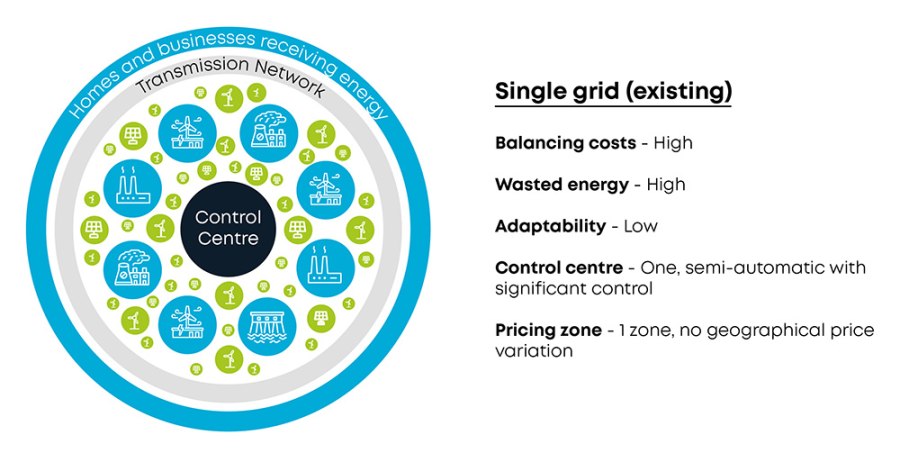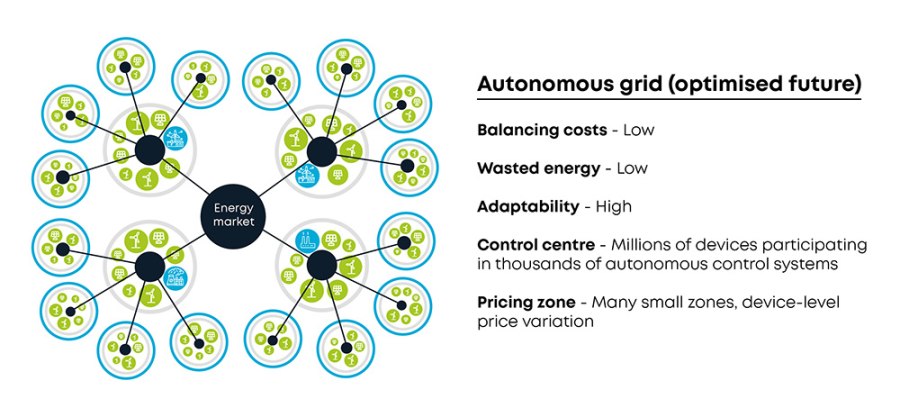The notion that the electricity grid should be controlled completely autonomously – that is without any significant human control – currently sits quite high on the scale of implausibility. But stay with me. I contend that the increasing operational instability and cost of the grid may well make autonomy a requirement of the future. The necessary technological approaches might be in their infancy in infrastructure terms; but make no mistake: significant opportunity lies just beyond the horizon.
In this article, I want to explore the opportunities and technical challenges associated with the autonomous electrical power grid and unpack what I deem to be the three key enablers of such an advance, which are automation (naturally), decentralization and data connectivity. But let’s start with the current lie of the land.
Electrical Review 150th Anniversary
With the electricity grid becoming more unstable and expensive to operate, new market structures and mass participation in grid planning and control are becoming key problem-solving tools. But this direction of travel means that the complexity of the future system will be beyond the capability of today’s centralized methods. An autonomous, decentralized approach could solve this, but there are a number of unique challenges that must be addressed.
Today, all electricity grids operate by balancing energy used with energy generated in real time. Grids were originally designed as top-down systems with central energy sources connected to a transmission network, which in turn feeds many regional distribution networks that deliver electrical energy to homes and businesses. The electricity grid is now changing with more renewable energy generation and storage being connected to the distribution network either directly from large wind and solar farms or through distributed resources in homes and businesses.

Constraint costs and balancing services
This evolving grid architecture requires more effort to maintain the balance between generation and demand, which is reflected in higher system balancing costs. These costs ultimately get passed onto consumers in their bills. The dynamics at play here involve constraint costs and balancing services. The former is where too much energy is being generated for the grid to handle, so generators are paid to disconnect from the grid, which is not only expensive but wasteful as the energy is often 100% renewable low carbon energy. The latter – balancing services – is where the planned generation and predicted demand do not match reality, so extra generation or reduced demand has to be procured and dispatched in real time, normally at higher cost. All this means that the future grid requires a new mechanism to optimize the dispatch of energy to reduce these costs.
So where are we heading? In short, towards nodal pricing, which replaces a single electricity price across the whole grid area with lots of energy prices depending on location. We’re already seeing this infrastructure being used in the United States, New Zealand, Canada and Singapore.

A nodal grid provides a local price signal to the market, influencing investment and operational decisions on where energy generation or storage should be added and dispatched, and if and when energy should be used at all. Centralized algorithms are used to determine how to supply the required energy in a more efficient way. This ensures that resources are in the right place and are dispatched in the right way to avoid balancing costs and wasteful curtailment. The pricing zones are however limited to where energy enters and exits the transmission grid and still relies on manual monitoring and central control to ensure supply and demand are balanced in real time.
While this would be a significant step forward for today’s mix of electricity generation and storage, while smoothing the supply demand challenges, this approach must evolve further for the grid of the future to meet its potential. A more ambitious goal would be the complete removal of the need to balance or curtail the grid by optimizing the level of supply, storage and demand in real time so that unplanned energy dispatch or curtailment of resources is minimized. In in other words, an autonomous energy grid that matches supply and demand without central control or planning.
This would offer significant benefits including, but not limited to:
- Generators – more predictable long term investment planning; new opportunities for higher ROI in areas that require generation or becoming aggregators of distributed energy resources; reduced network usage and balancing charges
- Distribution System Operators (DSO) – less variable demand on system, reducing investment required due to the increase in overall electricity use
- Transmission System Operators (TSO) – as per DSO, plus less balancing/curtailment effort required, and hence lower costs incurred
- Suppliers – new opportunities to provide home energy management, peer-to-peer energy/flexibility trading and carbon/energy emissions tracking services; reduced network usage and balancing charges
- Consumers – lower bills, more resilient system and potential to get a better return on distributed energy resources and demand response
- All – lower CO2 emissions, less energy waste, more stable system
The autonomous promised land
So how do we get to this future autonomous promised land? For an autonomous grid to work, mass participation in the energy grid operation is required, meaning businesses or domestic consumers would be able to freely trade their power generation, storage or demand. This would result in a much more resilient and lower cost grid.

The combination of distributed energy resources, nodal pricing and mass participation in providing services to the grid (not to mention the need to track CO2 and energy use) will result in the grid becoming too complex to control with an automated centralized system – so an autonomous decentralized approach may be the inevitable. This is because of the unique combination of requirements to:
- Have a trusted record (an account) of what energy was used, where it came from, what its associated carbon emissions are, who used it and for what purpose
- Provide a mechanism to connect generators, operators, and users without needing to trust them
- Ensure engagement in the system, by removing as many barriers to participation as possible
This particular combination of needs is a strong use case for a decentralized architecture, using Web3 technology for example. This would enable consumers and businesses to participate in markets for generation, storage, and demand response, which could potentially automate the control of the electricity grid.
The key challenges and approaches necessary for a grid to become autonomous and decentralized
Optimization algorithms. The question here is this: how can grid optimization algorithms securely access the data they need from millions of devices across many organizations and locations and then resolve the optimal system configuration on a second-by-second basis? The answer could be through the creation of a federated data space for the energy grid and a decentralized autonomous approach, splitting the grids up into many smaller self-optimizing areas.
Asset registration. How can we allow for safe registration of untrusted assets onto the system? Through a decentralized identification system. In it, a public key for each ID could be stored on a suitable blockchain enabling trusted organizations and services to securely interact with it, providing credentials and interrogating the device’s status.
Privacy. How can consumers’ sensitive energy-use data be protected? With the use of privacy enhancing technologies such as zero-knowledge proofs, homomorphic encryption, compute-to-data or federated learning.
Transaction settlement. Is transaction settlement between millions of devices per second possible? Yes, by dividing the grid into small subunits combined with a decentralized transaction record mechanism like a distributed ledger.
Energy and carbon tracking. How can energy use and associated carbon intensity be tracked most effectively in this architecture? Through the tokenization of energy and recording of energy token transactions in a suitable distributed ledger environment.
Connectivity and data storage/compute infrastructure. How can the communications infrastructure provide the required level of service with all devices? By making use of existing smart metering comms systems in homes and the many different types of IoT connectivity for grid operators and businesses. Compute and data storage could also be provided at the edge of the network where service requirements demand.
Data connectivity, decentralization and automation
As I said at the outset, the themes of data connectivity, decentralization and automation emerge from our proposed approach to resolving the key challenges in creating an autonomous decentralized grid. Each of these are key enablers for the future grid, which themselves present significant technical challenges such as:
- Data connectivity – federated data spaces, compute to data and privacy enhancing technology
- Decentralization – distributed ledgers, tokenisation and decentralised apps (dApps)
- Automation – smart contracts, building the industrial metaverse and AI algorithm training
These technologies are immature in critical infrastructure and will require significant research and development, design, proof of concept validation and implementation effort to successfully realize. The good news is that there is a growing effort to undertake this research and develop these proof-of-concept systems.
Federated data spaces are being formed in many sectors including automotive, transport and energy and the large cloud data platforms are embracing enhanced privacy functionality to make their data more widely accessible. The industrial metaverse [opinion article nearing completion] is creating a virtual space in which to link digital twins and train AI to optimize critical infrastructure without the risk of damaging physical infrastructure. And the growing Web3 movement is making progress in developing decentralized systems with thousands of projects across all markets from gaming to finance.
This Web3 movement also includes the energy sector, where use cases such as carbon emissions tracking and peer-to-peer energy trading are finding technical solutions with the potential to unleash significant value.
These are exciting times indeed – so do please reach out to me by email of you’d like to discuss the topic in more detail. Meanwhile, here is some wider reading from CC on associated themes: Sustainability, energy, smart infrastructure and 5G and wireless connectivity
This article was originally published as Smart Grid in Electrical Review’s 150th anniversary edition





